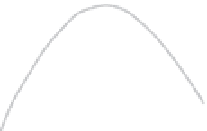Agriculture Reference
In-Depth Information
efficient in increasing photosynthesis than
when the radiation is high (Fig. 6.4).
In general, if the photoperiod is reduced
or extended and the radiation intensity is
varied in such a way that the accumulated
radiation is the same, the growth rates will
be similar (Langhams and Tibbitts, 1997).
It must be expected that the longer the
duration of the light period, the more photo-
synthesis will take place. But it may be that,
due to incapacity to store all the starch (pro-
duced by photosynthesis) the leaf stops its
assimilating activity.
In practice, at the level of an isolated leaf
it is possible to reach this saturation point,
but in a fully developed leaf canopy (where
the lower leaves receive little radiation as
they are shaded) it is nearly impossible to
reach saturation to radiation by a commercial
greenhouse crop (Plate 12) (Hanan, 1998).
Within closed canopies it is very
unlikely that saturation radiation levels can
be reached with global radiation intensities
below 1000 W m
−2
(Bakker, 1995). A well-
developed crop (high leaf area index, LAI)
obviously will photosynthesize more than
another one with lower LAI (Fig. 6.5).
This radiation saturation level also
depends on other factors, for example tem-
perature and of the CO
2
content of the air
(Fig. 6.6) (Urban, 1997a). The excess of radi-
ation may damage the photosynthetic com-
plex, for example destroying chlorophyll,
making the foliage chlorotic and eventually
reducing the photosynthetic productivity of
the plants.
Radiation controls photosynthesis not
only by its intensity (Fig. 6.5), but also
through the available wavelengths and its
duration. The proper radiation level to satu-
rate the photosynthetic system of many
plants (C3 type) is around 400 mmol m
−2
s
−1
,
when supplied for 16 h day
−1
, whereas other
plants (C4 type) require levels of 500 mmol
m
−2
s
−1
or higher to maximize their growth
(Langhams and Tibbitts, 1997). By contrast,
some ornamental plants develop well with
levels ranging from 10 to 50 mmol m
−2
s
−1
for
a period of 8 h (Langhams and Tibbitts, 1997).
We distinguish between shadow plants and
plants with high light requirements, depend-
ing on their response to radiation. In shadow
plants, the saturation point is reached with
low radiation levels, which is not the case for
radiation-demanding plants, in which the
compensation point is higher. The edible
horticultural species usually have high com-
pensation points (Urban, 1997a).
In the majority of the plants low levels
of radiation intensity induce smaller leaves
(with higher length:width ratio), longer
Gross
photosynthesis
Net
photosynthesis
High
radiation
Medium
radiation
Low
radiation
Very low
radiation
Respiration
0
0
0
Temperature
0
LAI
Fig. 6.5.
Net photosynthesis as a function of the
leaf area index (LAI) and the radiation intensity
(adapted from Urban, 1997a).
Fig. 6.6.
effect of temperature on respiration and
gross and net photosynthesis of a C3 plant
(adapted from Urban, 1997a).









